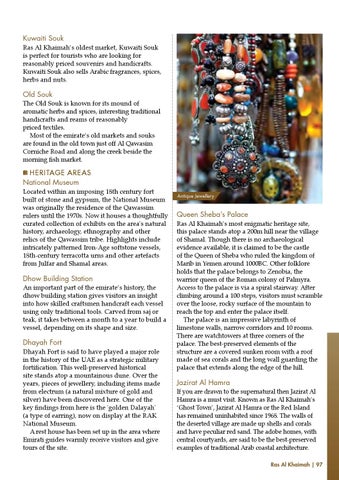Kuwaiti Souk
Ras Al Khaimah’s oldest market, Kuwaiti Souk is perfect for tourists who are looking for reasonably priced souvenirs and handicrafts. Kuwaiti Souk also sells Arabic fragrances, spices, herbs and nuts.
Old Souk
The Old Souk is known for its mound of aromatic herbs and spices, interesting traditional handicrafts and reams of reasonably priced textiles. Most of the emirate’s old markets and souks are found in the old town just off Al Qawasim Corniche Road and along the creek beside the morning fish market.
HERITAGE AREAS National Museum
Located within an imposing 18th century fort built of stone and gypsum, the National Museum was originally the residence of the Qawassim rulers until the 1970s. Now it houses a thoughtfully curated collection of exhibits on the area's natural history, archaeology, ethnography and other relics of the Qawassim tribe. Highlights include intricately patterned Iron-Age softstone vessels, 18th-century terracotta urns and other artefacts from Julfar and Shamal areas.
Dhow Building Station
An important part of the emirate’s history, the dhow building station gives visitors an insight into how skilled craftsmen handcraft each vessel using only traditional tools. Carved from saj or teak, it takes between a month to a year to build a vessel, depending on its shape and size.
Dhayah Fort
Dhayah Fort is said to have played a major role in the history of the UAE as a strategic military fortification. This well-preserved historical site stands atop a mountainous dune. Over the years, pieces of jewellery, including items made from electrum (a natural mixture of gold and silver) have been discovered here. One of the key findings from here is the golden Dalayah (a type of earring), now on display at the RAK National Museum. A rest house has been set up in the area where Emirati guides warmly receive visitors and give tours of the site.
Antique Jewellery
Queen Sheba’s Palace
Ras Al Khaimah’s most enigmatic heritage site, this palace stands atop a 200m hill near the village of Shamal. Though there is no archaeological evidence available, it is claimed to be the castle of the Queen of Sheba who ruled the kingdom of Marib in Yemen around 1000BC. Other folklore holds that the palace belongs to Zenobia, the warrior queen of the Roman colony of Palmyra. Access to the palace is via a spiral stairway. After climbing around a 100 steps, visitors must scramble over the loose, rocky surface of the mountain to reach the top and enter the palace itself. The palace is an impressive labyrinth of limestone walls, narrow corridors and 10 rooms. There are watchtowers at three corners of the palace. The best-preserved elements of the structure are a covered sunken room with a roof made of sea corals and the long wall guarding the palace that extends along the edge of the hill.
Jazirat Al Hamra
If you are drawn to the supernatural then Jazirat Al Hamra is a must visit. Known as Ras Al Khaimah’s ‘Ghost Town’, Jazirat Al Hamra or the Red Island has remained uninhabited since 1968. The walls of the deserted village are made up shells and corals and have peculiar red sand. The adobe homes, with central courtyards, are said to be the best-preserved examples of traditional Arab coastal architecture. Ras Al Khaimah | 97
